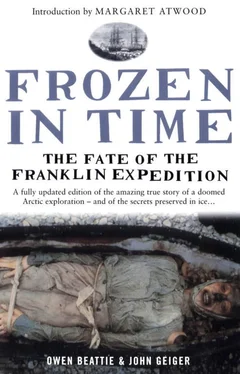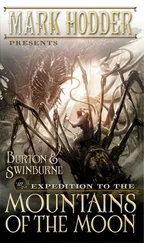Fitzjames sent home a journal in which he described the journey from Stromness to Disco—as well as many of his companions—and outlined his feelings for Franklin: “We are very happy, and very fond of Sir John Franklin, who improves very much as we come to know more of him. He is anything but nervous or fidgety: in fact I should say remarkable for energetic decision in sudden emergencies.”
The respect felt for Franklin was widely shared. A formal but affable character, Franklin was well-liked by his men. Lieutenant James Walter Fairholme, a 24-year-old officer aboard the Erebus, wrote to his family explaining, “he has such experience and judgement that we all look on his decisions with the greatest respect. I never felt that the Captain was so much my companion with anyone I have sailed with before.”
After saying farewell, Lieutenant Edward Griffiths, commanding the Barretto Junior, sailed back to Britain. He took with him members of the expedition, making a total of five who had already become ill enough to be sent home: three petty officers, one Royal Marine and an able seaman. Griffiths later described the spirits of the expedition as high and observed that the supplies, including the quality of the tinned foods, seemed quite satisfactory for the planned voyage.
A dog named Neptune and a pet monkey named Jacko accompanied the 129 sailors when, on 12 July, they pushed westward. Their last contact with the outside world came at the end of July, in Baffin Bay, where they met two whaling ships, one named Prince of Wales, the other, Enterprise. Franklin was waiting for conditions to allow for a crossing of Baffin Bay to Lancaster Sound. Captain Dannett of the Prince of Wales reported inviting Franklin and several of his officers aboard. “Both ships’ crews are all well, and in remarkable spirits, expecting to finish the operation in good time. They are made fast to a large iceberg, with a temporary observatory fixed upon it,” Dannett recorded in his log.
Captain Robert Martin of the Enterprise noted that Franklin said he had provisions for five years, and if it were necessary he could “make them spin out seven years.” Martin added that Franklin told him he would “lose no opportunity of killing birds and whatever else was useful that came in the way, to keep up their stock, and that he had plenty of powder and shot for the purpose.”
Martin was invited to dine aboard the Erebus, but shifting winds sent the ships apart, and so it was that in early August 1845, Franklin and his crews lost contact with their world. The Erebus and Terror were last seen making for Lancaster Sound, the eastern entrance to the Northwest Passage, where they would enter the desert of silence beyond.
There was no anxiety at first. Unease about the status of the Franklin expedition only crept into the minds of the Admiralty’s London officials at the end of 1847. In March 1848, the need for a relief expedition was first raised in the House of Commons, where a confidant of Jane, Lady Franklin asked what, if any, steps the government might take regarding a search. The response confirmed that there was cause for concern, because the expedition had enough food only for three years, meaning its supplies would shortly be exhausted. None could have guessed that their worst nightmares were already about to play themselves out on the desolation of King William Island.
In 1848, the Admiralty dispatched three expeditions to relieve Sir John Franklin. Captain Henry Kellet was instructed to sail to the Bering Strait, where Franklin was to break free of the Arctic ice; a second expedition, under the command of Sir James Clark Ross, was sent into Lancaster Sound, following Franklin’s original route, and an overland party led by Dr. John Rae and Sir John Richardson was sent down the Mackenzie River. It was the failure of all three of these relief expeditions to find a trace of Franklin that finally sparked the fear that something might have gone terribly wrong. Ross’s experiences especially contributed to the growing sense of foreboding.
With Franklin’s disappearance, Ross’s wife’s entreaties—now coloured by the knowledge that it might have been her husband for whom they sought—were overridden by the Admiralty’s orders for Ross to command one of the relief expeditions. Rather than relieve Franklin, however, Ross very nearly replicated the disaster.
Ross, with his wealth of Arctic experience, well understood the need to defend against scurvy. When the Enterprise and Investigator, two barque-rigged sailing vessels, departed the Thames in tow of two steam tugs on 12 May 1848, the ships had been provisioned for three years, with an additional year’s stores for Franklin’s crews. The ships carried plenty of preserved meats as well as canned potatoes, carrots and mixed vegetables such as beets and cabbage; while the expedition still carried salt beef and salt pork, tinned foods constituted the bulk of the provisions. In consequence, Ross remarked that his Franklin relief voyage was exceptionally outfitted by the navy. “Long experience and liberal means gave us many comforts that no other expedition had enjoyed,” Ross would later write, “yet it is remarkable that the health of the crew suffered more during this winter than on any former occasion.”
As winter quarters for the Enterprise and Investigator (the latter commanded by Captain Edward Henry Bird), Ross chose Port Leopold, on the northeast coast of Somerset Island. Here, on the eastern shore of the harbour, a narrow beach stretches out in a series of ridges below a bluff. The western side is steep and very high; its headland named Cape Seppings. On arrival, the two ships sent rockets up every evening and morning in the event that Franklin’s men were in the vicinity. But the ships, moored some 200 yards (183 metres) apart, were soon frozen fast, and the crew immediately set to work in preparation for winter. A wall of snow 7 feet (2.1 metres) high was built linking one ship to the other, to aid with crossings during blizzards. In mid-October, winter awnings of “stout wool” were erected over the decks of each ship to afford protection from the wind and snow.
Men of the search expedition commanded by James Clark Ross construct their winter quarters.
A concise account of the expedition was kept by James D. Gilpin, clerk-in-charge on the Investigator, and he recorded the news of the first death on 27 October 1848. “William Coombes, of the carpenter’s crew, died: he had been long wasting away and expired at noon this day. The disease I understood was in the brain, and contracted previous to his servitude in the Investigator” Coombes was buried three days later, during the gloom of a heavy snowfall. Wrote Gilpin:
All hands attended the funeral, a mournful duty at all times, but particularly so here where the wild prospect around us contributed so much to the melancholy of the occasion. A more affecting spectacle cannot be than to behold a number of men in mournful procession, walking through deep snow, and drawing after them a sledge bearing a coffin shrouded with the bright colours of Old England.
The scene was a harbinger of the difficult winter ahead. For the expedition’s outbreak of illness was every bit as rapacious as that experienced by George Back in 1836–37, and also attributed to scurvy—a debilitating toll aggravated by the urgency of Ross’s quest.
Several days after Coombes’s funeral, on 9 November, the sun disappeared. It would not return until 9 February 1849. The dreary winter routine aboard-ship was interrupted only by the trapping of Arctic foxes. The animals were fitted with copper collars around the neck, upon which were punched the name of the ship, their position and date “in the hopes that Sir John Franklin, or some of his people, might in the ingenious manner be apprised of assistance.”
Читать дальше










